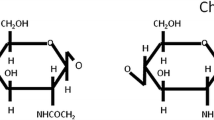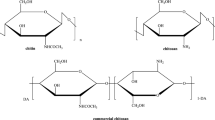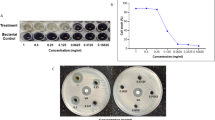Abstract
In the study, chitosan chemically extracted from Metapenaeus stebbingi shells obtained from shrimp processing factories and commercial chitosan were used as antimicrobial materials. Antimicrobial activities of the chitosans dissolved in acetic, lactic, formic and hydrochloric acid at different concentrations (1.00, 0.50, 0.25, 0.10 and 0.05%) were tested in vitro by using the disk diffusion method with standard microorganisms (Pseudomonas putida, Pseudomonas fluorescens, Vibrio parahaemolyticus, Staphylococcus epidermidis, Staphylococcus aureus, Escherichia coli 1, Escherichia coli 2, Listeria monocytogenes, Enterecoccus faecalis, Aeromonas caviae). On the other hand, gentamicin was used as positive control. Antimicrobial test results indicated that chitosan demonstrated different effects depending on the chitosan concentration, solvent material and bacteria type. In the present study, both the extracted and commercial chitosans were observed to have antimicrobial effects on nearly all types of the bacteria.
Similar content being viewed by others
References
Jeuniaux C, Vossfoucart MF (1991) Biochem Syst Ecol 19:347
Ruiz-Herrera J (1978) The distribution and quantitative importance of chitin in fungi. In: Muzzarelli RAA, Pariser ER (eds.) Proceedings of the first international conference on chitin/chitosan. MIT Sea Grant Report MITSG78-7, Index No. 78-307-Dmb. Massachusetts Institute of Technology, Cambridge, pp. 11–21
Sandford PA (2003) Commercial sources of chitin and chitosan and their utilization, In Vårum KM, Domard A, Smidsrød O (eds.) Advances in chitin sciences, vol 6. NTNU Trondheim, Trondheim, p 35
Yen MT, Yang JH, Mau JL (2009) Carbohydr Polym 75:15
Hongpattarakere T, Riyaphan O (2008) Songklanakarin J Sci Technol 30:1
Jeon YJ, Kamil JYVA, Shahidi F (2002) J Agric Food Chem 50:5167
Rabea EI, Badawy MET, Stevens CV, Smagghe G, Steurbaut W (2003) Biomacromolecules 4:1457
Tsai GJ, Zhang SL, Shieh PL (2004) J Food Protect 67:396
Tikhonov VE, Stepnova EA, Babak VG, Yamskov IA, Palma-Guerrero J, Jansson HB, Lopez-Llorca LV, Salinas J, Gerasimenko DV, Avdienko ID, Varlamov VP (2006) Carbohydr Polym 64:66
Zheng LY, Zhu JF (2003) Carbohydr Polym 54:527
Fouad DRG (2008) Chitosan as an antimicrobial compound: modes of action and resistance mechanisms. Mathematisch-Naturwissenschaftliche Fakultät, Universität Bonn
Chang KLB, Tsai G, Lee J, Fu WR (1997) Carbohydr Res 303:327
Tolaimate A, Desbrières J, Rhazi M, Alagui A, Vincendon M, Vottero P (2000) Polymer 41:2463
Wang QZ, Chen XG, Liu N, Wang SX, Liu CS, Meng XH, Liu CG (2006) Carbohydr Polym 65:194
Wang JC, Kinsella JE (1976) J Food Sci 41:286
Bauer AW, Kirby WM, Sherris JC, Turck M (1966) Am J Clin Pathol 45:493
Li Q, Dunn ET, Grandmaison EW, Goosen MFA (1992) J Bioactive Comp Polym 7:370
Nemtsev SV, Gamzazade AI, Rogozhin SV, Bykova VM, Bykov VP (2002) Appl Biochem Microbiol 38:521
No HK, Meyers SP (1997) Preparation of chitin and chitosan. In: Muzzarelli RAA, Peter MG (eds). Chitin handbook. European Chitin Society, pp 475–489
Jeon YJ, Park PJ, Kim SK (2001) Carbohydr Polym 44(11):71
No HK, Kim SH, Lee SH, Park NY, Lee SH, Prinyawiwatku W (2006) Carbohydr Polym 65:174
Yang TC, Chou CC, Li CF (2005) Int J Food Microbiol 97:237
Darmadji P, Izumimoto M (1994) Meat Sci 38:243
Jia ZS, Shen DF, Xu WL (2001) Carbohydr Res 333:1
Jumaa M, Furkert FH, Muller BW (2002) Eur J Pharm Biopharm 53:115
Shigemasa Y, Minami S (1995) Biotechnol Genet Eng Rev 13:383
Liu WG, De Yao K (2002) J Control Release 83:1
Xia WS, Wu YN (1996) J Wuxi Univ Light Ind 15:297
Seo S, King JM, Prinyawiwatkul W, Janes M (2008) J Food Sci 73(8):400
Tajik H, Moradi M, Rohani SMR, Efrani AM, Jalali FSS (2008) Molecules 13:1263
Author information
Authors and Affiliations
Corresponding author
Rights and permissions
About this article
Cite this article
Küçükgülmez, A., Gülnaz, O., Celik, M. et al. Antimicrobial Activity of the Chitosan Extracted from Metapenaeus stebbingi Shell Wastes. J Polym Environ 20, 431–437 (2012). https://doi.org/10.1007/s10924-011-0395-0
Published:
Issue Date:
DOI: https://doi.org/10.1007/s10924-011-0395-0




